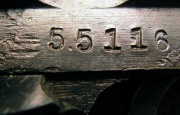Serial number
Gun grabbers also seem to have a peculiar obsession with serial numbers, apparently wanting to put a number on everything they can think of (see Microstamping for an example of this neurosis in action). Not surprisingly, they seem impervious to facts pointing out that serial numbering has a minuscule, if any at all, effect on crime. Ironically, while gun-grabbers desperately yearn to have SNs help prop up their cause, they are more often used to debunk anti-gun claims[1].
Contents |
[edit] Not unique
Contrary to popular belief, a serial number is not absolutely guaranteed to be unique. This inconvenient fact came to greater light when Canada began implementing their infamous long gun registry in the late 1990s. An Access to Information Act request in 2002 revealed that 222,911 guns, in 83,844 different combinations, in the registry had the same serial numbers as at least one other firearm in the database[2]. The registry also contains 250,305 firearms registered with the same SNs as stolen guns[3].
There are several reasons why two different firearms can have the exact same SN. The most common cause is when a factory numbers each gun not with its own number, but rather with a number to identify the batch or date of completion. While uncommon in peacetime, the practice was ofter used during wars in the 20th century in order to hamper enemy efforts to estimate arms production.
Many collectors of WWII German firearms have also observed that several of the same model firearm can have the same SN but they will also bear another marking, sometimes incorporated into the SN and sometimes not, which indicates the place of manufacture.
Prior to 1968 in the United States, many manufacturers utilized the same serial number configurations on multiple models of guns.
[edit] Legal status
Almost all western countries require by law that serial numbers be stamped on every firearm manufactured in or imported into their territory. One notable exception is Canada which, despite a plethora of onerous gun laws having been passed since the early 1990s, still has no law requiring SNs on firearms manufactured in that country.
An odd contrast to Canada is the United States which, despite having the Second Amendment guaranteeing their right to keep and bear arms, has had serial numbering on all firearms mandated since the passage of the Gun Control Act in 1968.
Most countries also make it a serious criminal offense to deface a firearm in such a way as to obscure its serial number (if it has one) or other identifying markings.
[edit] Uses
Contrary to anti-gun propaganda, SNs on firearms were not originally implemented for any purpose that was in any way connected with gun control, theft, or any other legal issue at all. The actual purpose was really quite simple: quality control.
Modern manufacturing techniques and machinery meant not only that many more firearms could be produced in a given time, it also meant that if an imperfection existed in one firearm from a particular factory, it likely existed in a great many more. Serial numbering would help determine which batch a particular gun belonged to and therefore help isolate the cause of the defects more quickly, minimizing down time and other causes of lost revenue.
Despite the fact that serial numbers are often — and not entirely without justification — viewed as merely a "thin end of the wedge" for use by gun grabbers, there actually are a few useful applications for them.
- Theft: having a record of the SN can help you to claim a recovered firearm.
- Buying: being able to do a SN check can help you avoid inadvertently buying a stolen gun.
- Dating: If contemporary records are available, a SN can help to confirm the age of a gun (obviously useful for antiques)
- Appraisal: mismatched SNs on components are a good indicator that a gun is not in original condition.
[edit] See also
- Firearm microstamping
- Myths about serial numbers
- Ballistic fingerprinting
- Cooey model 39 - one example of a gun that went through its entire production run without a SN on a single gun.
[edit] Notes
- ↑ The 90% nonesense, Gun Owners' Resource, 04-02-2009
- ↑ Access to Information Request A01-0323, Access to Information and Privacy Office, 04-10-2002
- ↑ Access to Information 03ATIP-27355, RCMP, 09-11-2003
